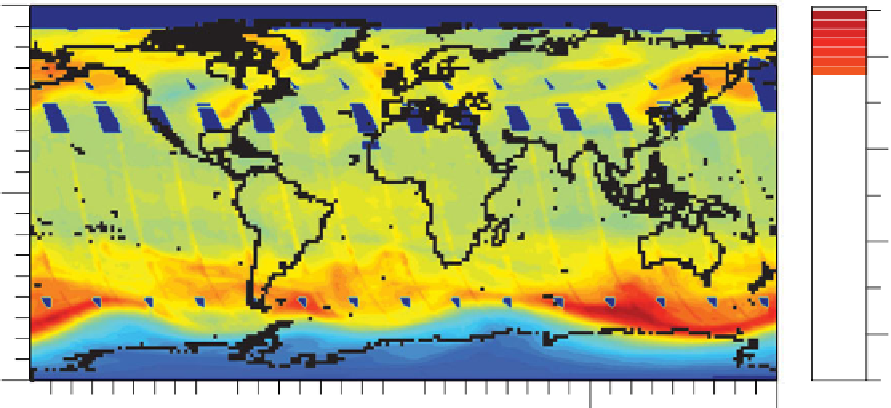Geoscience Reference
In-Depth Information
Ozone (DU) Oct. 3, 2010 (Global: 287.1; 60-90S: 223.6)
90
400
300
0
200
100
-90
-180
-90
0
90
180
Figure 11.16.
Ozone column abundance (in DU) on October 3, 2010. The ozone hole appears over the
Antarctic and an ozone maximum appears just outside the Antarctic. No data were available over the North
Pole (dark blue). Data were obtained from Total Ozone Mapping Spectrometer (TOMS) satellite and were
made available by NASA Goddard Space Flight Center, Greenbelt, Maryland.
Arctic if temperatures are low enough for certain types
of ice crystals to form. If such crystals form, reactions
occur on their surface releasing compounds that ulti-
mately destroy ozone. These processes are discussed
next.
particles (Toon et al., 1986). Initially, nitric acid and
water molecules were believed to deposit to the ice
phase in the ratio, 1:3. Such ice crystals have the com-
position HNO
3
·
3H
2
O and are called
nitric acid trihy-
drate
(NAT) crystals. Subsequently, stratospheric par-
ticles were found to contain a variety of phases. Some
contain
nitric acid dihydrate
(NAD) (Worsnop et al.,
1993), and others contain supercooled liquid water (i.e.,
liquid water present at temperatures below the freezing
point of water) and sulfuric and nitric acids (Tabazadeh
et al., 1994). Together, nitrate-containing cloud parti-
cles that form at temperatures below about 195 K in the
winter polar stratosphere are called
Type I polar strato-
spheric clouds
(PSCs). Typical diameters of Type I
PSCs are 1
11.8.1. Polar Stratospheric Cloud Formation
The ozone hole over the Antarctic appears in part
because the Antarctic winter (June-September) is very
cold. Temperatures are low because much of the polar
region is exposed to 24 hours of darkness each day
during the winter, and a wind system, the
polar vor-
tex
,circles the Antarctic. The vortex is a polar front
jet stream wind system that flows around the Antarctic
continent, trapping cold air within the Antarctic polar
region and preventing warm, ozone-rich air from out-
side this region into it from penetrating into the Antarc-
tic stratosphere.
Because temperatures are low in the Antarctic and
sometimes Arctic stratosphere, optically thin clouds,
called
polar stratospheric clouds (PSCs)
form there
(Figure 11.17). These clouds have few particles per
unit volume of air in comparison with tropospheric
clouds. Two major types of clouds form. When tem-
peratures drop to below about 195 K, nitric acid and
water vapor grow on small sulfuric acid-water aerosol
m, varying from 0.01 to 3
m, and typical
1 particles cm
−
3
.Assuch,
these cloud particles are much smaller than are typical
tropospheric liquid cloud drops, which are 10 to 20
number concentrations are
≤
m
in diameter, and cirrus cloud ice crystals, which are 30
to 80
mindiameter.
When temperatures drop further, to below the frost
point of water (187 K for typical polar stratospheric
conditions), water vapor rapidly deposits on an existing
aerosol particle's nucleus, creating a more typical ice
crystal. Except for its nucleus, the resulting crystals
contain almost pure water ice. These crystals are called
Type II polar stratospheric clouds
(PSCs).





Search WWH ::

Custom Search